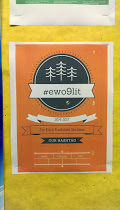Sorry for the tease: This post isn’t about the controversy over the Confederate flag or a celebration of SCOTUS’s decision regarding marriage equality. It’s about flying the flag of my tribe. On Day 10 of the Adaptability Project summer seminar, we discussed whether or not it was okay to blog about some of the details of our work; especially since part of our process is “stealthstorming.” There are good arguments on both sides of the issue, with some folks favoring stealth and some favoring transparency. In the end, I feel compelled to blog about the Adaptability Project because I am who I am: Hoist the Jolly Roger! I’m a Connected Educator!

Many Connected Edus are influenced by Dave Burgess’ book, Teach Like a Pirate.
On the first morning of the Adaptability Project’s summer seminar, I shared a chart with my colleagues that showed the structural problem with independent schools’ business model. (See this post.) The chart ended up in the presentations of both of the teams who were selected as the winners by the shark tank. Where did I first see that chart? I found it (via Twitter) on the blog of a fellow Connected Educator a few days earlier. (Tap –> Send to Pocket . . . trigger an IFTTT formula –> Send to Evernote) My fellow Connected Edus are out there sharing the best of what they know, night and day, and their knowledge and inspiration strengthens me. But it isn’t enough to take without giving. The dues you pay to be a Connected Educator are simple: You have to share, too.
Why do we do this? Why do we stay up late into the night hammering out blog posts that might be read by five people? Why do wake up at the crack of dawn on Saturday morning to participate in #satchat? Why do we get to conferences early to participate in an “unconference”? No one is paying us to do these things, and to most of our colleagues, these activities go unnoticed. What’s the point? Why bother?
Passion is the answer. Passion for our students, passion to build a better education system, passion for self-improvement, passion to use the most effective methods, passion to know what’s going on, passion for true comradery. We believe that there is strength in numbers, and when we get together to talk to each other on Twitter, we are usually trending. Is the American education system broken? If so, we’ll fix it. This isn’t a movement that’s content to sit around and accept the world as we find it. We challenge the status quo, we push for evidence, we are never satisfied. And when we see something that’s awesome, we retweet it or repost it, one thousand times if necessary.
These days I have two sets of colleagues. There are my fellow faculty members at George School, and then there is my PLN. The faculty at GS is limited to the number of people we need to run the school and educate 540 students in a residential setting. The potential pool from which to recruit one’s PLN is staggering.
Looking for a Head of School? You can’t do better than the enlightened (and argumentative) @JosieHolford. [blogs at http://www.josieholford.com/] Or check out @gregbamford or @zacklehman or, of course, @daar17.
Need to see what great teachers are up to? You better check out @Smacclintic. [blogs at http://smacclintic.edublogs.org/] Or check out the tireless @mssackstein. [blogs at http://blogs.edweek.org/teachers/work_in_progress/] Or my new PLN-pal @TrNancy13. [blogs at http://constanteaching.blogspot.com/]
Need a new dean for your Quaker school? I’m a little jealous of my FSL rival over at Westtown @lindamcguire_ . [blogs at http://www.lindamcguire.net/]
Now that I’ve gotten started on this list, I realize that I need to include about a hundred other people. All of my old #TABSchat friends, the moderators and contributors of #edtechchat, definitely the usual group at #isedchat, the deity @cybraryman1 [http://www.cybraryman.com/], @thenerdyteacher [http://www.thenerdyteacher.com/], @TheWeirdTeacher [http://hestheweirdteacher.blogspot.com/], and on and on. And you better follow The Pirate Captain @burgessdave [http://www.daveburgess.com/new/category/blog/]!
Some of these folks blog and microblog for an audience of their peers. Others are blogging for their students, or for the parents of their students. Some are blogging for an academic audience in higher ed. Some just want to get their thoughts down, and a blog beats paper because you can search it and hyperlink it. Maybe some of these folks want to be “thought leaders” or “build their brand” or whatever. That’s a fool’s errand, but if it leads to a generous sharing of ideas, I’m not going to judge. It takes a lot of fuel — emotional, intellectual, and spiritual fuel — to get out of bed every morning and work in the field of education. The Connected Educator movement is my I.V. drip of pure passion, and when I’ve got a bag of serum to spare, I need to get that thing hooked up to help all of the other teachers and administrators out there.
The school world would be a better place if everyone got connected. Sure, there would be more noise and tedious repetition. But the good ideas rise to the top. The ideas I’ve been working on with my teammates in the Adaptability Project were fueled by the Connected Educators movement, so I feel obliged to report back to my PLN on how their influence finds expression through this work. I’m proud of what we’re doing at George School this summer, and yes, I want everyone to know about it. We should fly our flag proudly.
Coda: I’d like to dedicate this post to the memory of Grant Wiggins. [His blog, now silent, is here.] I first became aware of Grant’s work at the Klingenstein Summer Institute in 2004 where he gave a day-long introduction to UbD. Then I worked with him briefly when he was hired to do some training for the faculty at The Hun School of Princeton when I worked there. Finally, when I came to George School in 2006, I discovered that Grant was a current parent, and three of his children are now GS alums. (I mentioned my proficiency with UbD in my interview when I applied to work here. I had no idea that Grant was part of the GS community at the time. I’m convinced it helped me get the job.) There are countless teachers online trying to break through the clutter and become “thought leaders.” As far as I’m concerned, Grant was one of the tiny handful who deserve that moniker. He was generous in his online interactions with scores of teachers who looked up to him, and he modeled civility in a Twittersphere that has no referees. I haven’t entirely finished processing the fact that Grant is no longer with us. His passing has left a giant hole right in the center of the educational blogging community. I don’t see how anyone is going to be able to fill that void.





